|
1.
CENTRAL/ WEST AFRICA
FOB prices largely unchanged
Although details of the log export ban in Gabon have not
yet been totally finalised, the log markets have remained
remarkably calm. The prospect of the loss of such a major
player from the log market has not resulted, as yet, in
noticeable price movements for logs.
Price changes that have been recorded over the past four to
six weeks have more to do with improved demand from
Europe. However these increases are built on a very low
level of demand and are still very moderate. Better
demand in China and India has also supported the modest
movement in prices.
Return of S. African buyers
Analysts report that South African importers allowed
timber stocks to run low and have now returned to the
market and are actively buying sawn Okoume. This has
encouraged sawmillers in Congo Brazzaville and Gabon to
raise prices and there are indications that sawn Okoume
prices will continue upwards into the second quarter.
Clarification also is awaited on details of the log export
situation in Cameroon. There has been relaxation on
exports of lesser know species and, more recently, some
indication that special dispensations may be made in
respect of prime timbers.
Currently, production across W. Africa is relatively low
because of the rain season, so finalising a firm decision in
log exports in Cameroon is not so urgent.
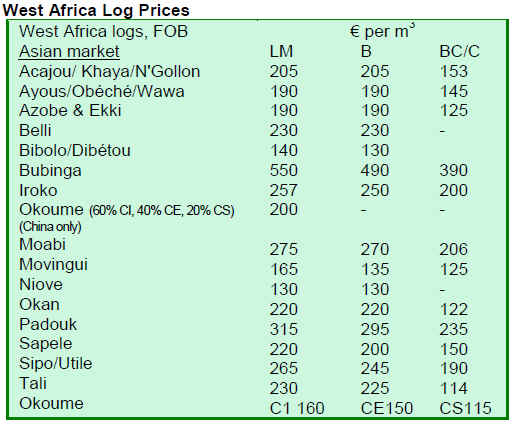

Positive trade expectations
Traders are reportedly expecting that Okoume, Okan,
Sapele and Sipo log export prices will continue to firm.
Higher log prices should encourage sawmills in the
Central African Republic to resume production of top
quality Sapele for export through the port of Douala.
Because of the high cost of road transport for the almost
1,000km journey, sawnwood exports via Douala is viable
only when prices are some Euro 30 ¨C 50 above the very
low level of recent months.
2. GHANA
Q4 timber contracts
Data available from the Timber Industry Development
Division of the Forestry Commission (TIDD) indicates
that contracts for a volume of 94,369 cubic metres (down
17% Qtr on Qtr) and 2,475 pieces of furniture parts were
processed and approved for export during the fourth
quarter of 2009.
There was a sharp increase in furniture parts export as a
result of two major parts shipments for the Togolese
market undertaken by Portal Limited, a Takoradi based
timber firm. The TIDD report indicates that Mim
Scanstyle Ltd, once the major furniture parts exporter,
submitted almost no contracts for export approval during
the same period.
In the fourth quarter 2009 there were declines in almost all
the major export wood products with the exception of
Finger Jointed/Laminated products, for which exports
(3,696 cubic metres) increased by 39% compared to the
previous quarter.
There were also declines in export volumes of sawnwood,
plywood, plantation poles/billets/logs, sliced veneer,
rotary veneer and mouldings compared to the previous
quarter.
Sawnwod continued to be the leading export wood product
from Ghana, contributing 47% of the total volume of
exports in the quarter.
Price and market performance
Overall there were no changes in prices during the quarter
under review. Prices were stable for most of the wood
products.
Though the global economic crisis, which led to a
meltdown of prices for wood products for most of 2009,
has eased, Ghana¡¯s exporters of wood products still find it
difficult to achieve prices above the TIDD Guiding Selling
Prices (GSP).
Prices of Mahogany (Khaya ivorensis), which is the main
sawnwood species for the US market, started to show
signs of improvement during the fourth quarter of 2009.
Most contract prices approved were at around US$750 per
cubic metres, with a few achieving as high as US$800 per
cubic metre. Prices in the previous quarter were in the
range of US$720 per cubic metre, well below the average
GSP level of US$860 per cubic metre.
China a major buyer
China is becoming one of the most important markets for
Ghana¡¯s wood products, especially for high density
sawnwood species. The majority of contracts for Denya
submitted for approval by the TIDD during the fourth
quarter 2009 were for the Chinese market. Prices were in
the region of US$400 per cubic metre. Previously, the best
average price was around US$350 per cubic metre.
Nigeria imports plywood
Nigeria continued to be the major consumer of Ghana¡¯s
plywood during the quarter under review. Due to the
depreciation of the US Dollar against the Euro, many
Nigerian buyers complained that the TIDD GSP for
plywood was on the high side, though TIDD prices quoted
in Euros had not changed.
New forest plan
According to a Ghana News Agency report, the Forestry
Commission is to update management plans for all forest
reserves in the country.
Apparently, plans over twenty forest reserves in the
country have been earmarked as pilot areas. Four pilot
areas namely, Nsuensa-Bediako, Esukawkaw, Pra-
Anuonand and Worebong South are in the Eastern Region.
At a 2-day planning workshop held to introduce a draft
management plan for the Nsuensa-Bediako Forest
Reserve, the Eastern Regional Forestry Manager, Mr. J E
Manu, said he wanted to bring all stakeholders in the
sector together for discussion on the plan to ensure the
effective and sustainable management of forest reserves.
Mr Manu said the Nsuensa-Bediako Forest Reserve
management plan was written in 1959 to cover a period of
five years but there had been no review undertaken since.
Ghana Log Prices

3.
MALAYSIA
Furniture exports set to recover
Exports of Malaysian furniture are expected to reach
RM10 billion for the current year according to the
Malaysian Deputy Plantation Industries and Commodities
Minister.
In 2009 furniture exports declined 12% to RM7.62 billion,
while the decline of timber and rattan furniture, which
constituted 84% of all furniture exports, fell just 7%.
Alternative materials for Malaysian furniture
The Forest Research Institute of Malaysia (FRIM) will
promote several alternative materials as suitable raw
materials for the furniture industry. FRIM will display
these materials during the Malaysian International
Furniture Fair (MIFF) 2010.
The objective in displaying the new raw materials is to
help address raw material shortages facing the furniture
manufacturing sector.
FRIM, the leading forestry research organization in
Malaysia, is also a strategic business partner to the
Malaysian timber industry. It has been in the forefront of
research into fast growing tree species for the timber
industry. FRIM is also an important centre for furniture
testing.
Rubberwood from Thailand
The shortage of raw materials, particularly sawn
rubberwood, in Malaysia has forced a number of
manufacturers to purchase timber from neighbouring
Thailand. However, competition for sawn rubberwood in
Thailand is especially stiff as buyers for the Chinese
market are active and placing huge orders.
Thailand consumes vast amounts of natural rubber for its
production of vehicle tyres and automotive parts. Because
of this strong demand and good prices for latex, rubber
plantations are generating good returns and owners can
keep the plantations standing, even when latex yields
begin to decline. This is leading to a shortage of
rubberwood logs.
Encouraging signs from EU buyers
Sawnwood producers and traders report encouraging news
of orders originating from Europe. While the size of the
orders do not indicate a major revival of the construction
sector in the EU, these are being interpreted as indicating
better demand for raw material for the manufacture of
window and door frames.
Remodelling postponed
The financial crisis in Europe over the past two years
resulted in many homeowners postponing planned
remodelling or renovation work. As fears of another
financial blow in the EU arising from the Greek economic
situation fades, European homeowners are said to be
showing signs of growing confidence and are looking to
undertake repairs caused by storms over the past winter.
With news that prices of non-wood building material are
set to rise, European consumers are reportedly
reconsidering timber for reconstruction work.
Analysts forecast a modest increase in purchases of
plywood and a steady recovery in timber prices over the
next few months.
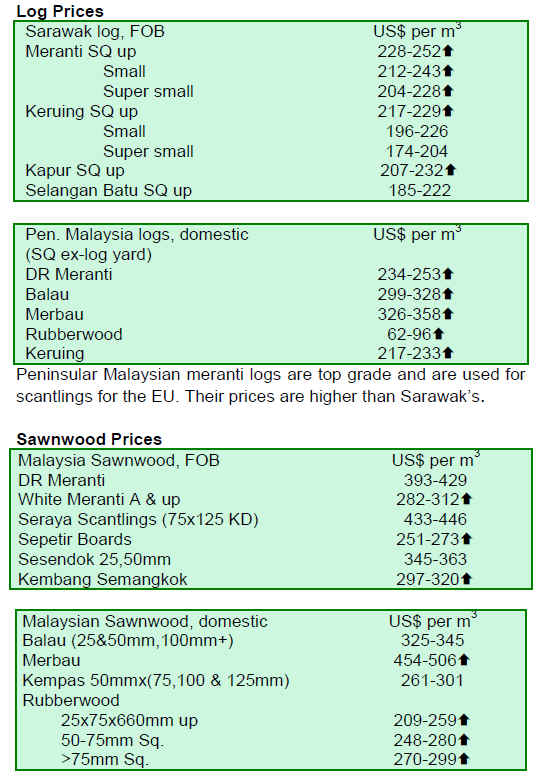
4.
INDONESIA
Reforestation in Jambi
Indonesia, together with Australia, has launched an A$30
million reforestation project in Sumatra in a bid to address
greenhouse gas emissions and introduce a carbon-trading
scheme under the REDD programme.
The project will be in Jambi Province in Sumatra and will
be the second such project undertaken by the two
countries. Funds will be used to restore forests in a
province that is larger than the Netherlands and has lost
more than 60% of its forests through illegal logging, slash
and burn agriculture and clearing for oil palm plantations.
USAID helps interpret Lacy Act in Indonesia
USAID is working with the Forestry Ministry of Indonesia
and various timber product and trade associations to help
Indonesian timber companies better understand the US
Lacey Act. Many Indonesian timber companies are still
unfamiliar with the Lacey Act and welcome the assistance
on how to prepare the various export documents required.
Timber tracking
USAID is also providing support for the development of a
timber tracking system in Indonesia. This is to help
operationalise a new Indonesian verification law that
requires full documentation of the supply-chain for timber
products from the point of harvesting to the processing of
the product.
Positive signs in domestic housing sector
Some Indonesian real estate developers have voiced
optimism that the national economy is showing signs of
recovery and that will mean the housing market is set to
improve.
Interest rates held steady
The Indonesian Central Bank has maintained the
benchmark lending rate at 6.5% for the seventh straight
month in order to promote more bank lending. In another
move to aid the ailing construction sector, the National
Electricity Board is offering developers substantial
discounts for switching their account to industrial status.
With the current buoyant prices for agricultural
commodities, especially palm oil, housing developers
believe that the Indonesian economy is set to grow on a
longer term basis.
Order books in better state
Timber traders and producers have reported that new
orders are steadily arriving and plywood manufacturers
share the same optimism as the housing developers.
Further fuelling optimism is the view that orders for
Indonesian plywood from Japan and South Korea are set
to rise.
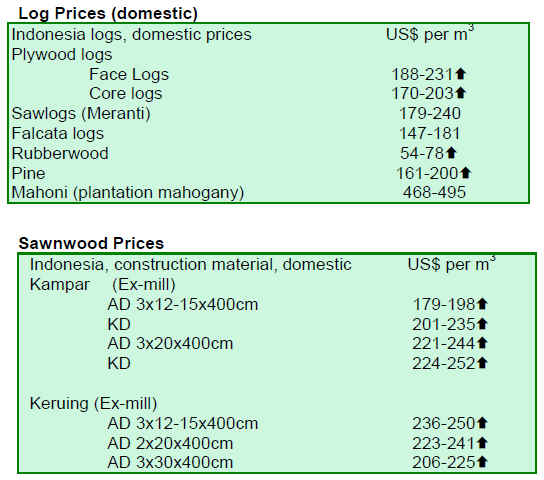
5.
MYANMAR
Sawnwood market slow
Traders are saying that the market for sawn teak is very
slow, enquiries are being received but firm orders are not
being realised.
Price drives Indian purchases
Teak logs, on the other hand, are in demand especially in
India but the catch in this market is ¡®reasonable price¡¯. If
teak log prices are right for the Indian market then buying
is active. This was reflected in last month¡¯s log auctions.
Grade VII logs are the most popular.
Pyinkado log stocks are currently being shipped out to
make room for the newly harvested logs in the log yards.
Buyers of the Pyinkado logs say shipment will be made
when the sales contracts are released by the authorities.
River transport of Gurjan
Gurjan logs from the four preferred areas Momeik,
Mawlaik, Monywa, and Mabein (known as the 4 M area)
have to be floated down the Chindwin and the Ayeyarwadi
rivers. These rivers will become more navigable in a
couple of months when the snow melts in the mountains
and river levels rise.
At the moment there is still a lot of log rafts and barges
waiting to be moved. Most will be sent to the auction
depots after the Myanmar New Year in April. The market
for Gurjan may become more active in April when more
buyers are expected to bid for the fresh logs. Analysts say
that Gurjan prices usually go down after April.
Gurjan logs are also shipped out in comparatively large
quantities from southern Tanintharyi (mainly Myeik
formerly known as Mergui) just before the onset of the
South-West Monsoon during which the sea becomes too
rough.
Design competition
The local journal ¡®Weekly Eleven¡¯ has reported that the
Myanmar Timber Merchants Association has extended the
deadline for the submission of furniture designs for its
competition. Designs may be sent to the Association
personally or by internet or mail. Winners will be
announced a Furniture Fair to be held on the 30th April
2010, at Nay Pyi Taw, the administrative capital of
Myanmar. Designers, both local and foreign, can
participate in the competition, the journal stated. Designs
can be submitted to the Timber Merchants Association at
mfptma@mptmail.net.mm or mfptma@gmail.com
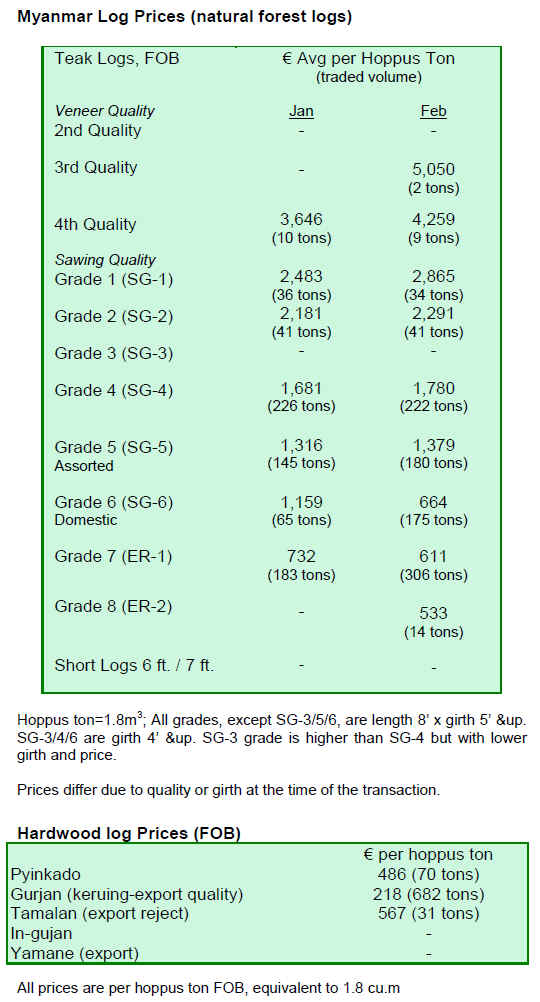
6. INDIA
Exports up three months in a row.
India¡¯s merchandise exports rose to US$14.34 billion in
January, up 11.5 % from US$12.86 billion in the same
month last year. Exporters are increasingly looking for
new products and new markets as growth in traditional
markets such as the USA and Europe is stagnant.
Imports surge
Imports also surged in January, increasing by 35% to US
$24.70 billion against US$18.22 billion a year ago. This is
a signal of strong domestic demand and investment.
India¡¯s Industrial Output Index has also risen thanks to
expanding output and new orders.
Housing market lifting prices
With the improving economic situation in India, it is not
surprising that house building activity has increased.
House prices in India are almost back to levels prior to the
economic slowdown in 2008/9. This is translating into
firming prices for wood and wood products in India and in
countries where India is buying logs.
Custom duties in India¡¯s budget
In the budget presented on 26th February, 2% has been
added to Central Excise. This means that all wood panel
products will attract a 10% counterveiling duty, making
them approximately 2.5% more expensive (inclusive of
surcharges). In the case of logs and sawn timber the duties
remain the same, a disappointment for importers who were
looking for a reduction.
Expanding forest cover.
As announced in the State of The Forests 2009 report, the
net forest cover in India has expanded.
The states reporting increased forest cover are: Himachal
Pradesh, Arunachal Pradesh, Jammu and Kashmir, Sikkim
Mizoram, Manipur Nagaland, Tripura Jharkhand, Orissa
and Uttara khand. On the other hand, Assam, Andhra
Pradesh and Chhattisgarh have reported declines in their
forest area.
The losses of cover can be due to mining sector
operations. The good thing is that there is a growing
awareness of the importance of increasing the ¡®green¡¯
cover.
Investment in downstream production
There is great potential for expanded panel product
manufacturing in India but the main problem is the
scarcity of wood raw materials.
Under these circumstances, making composite panels
using agricultural waste combined with wood chips is
gaining momentum.
Several production lines have been set up for
manufacturing agro-composite MDF and particleboard.
One such unit has been established in Gujarat by Rushil
D¨¦cor Limited using cotton stalks and wood.
Another factory has been built in Ankleshwar also in
Gujarat, producing particleboard from a bagasse and wood
mix. One more unit by Paralam Global Pvt Ltd is nearing
completion at Nagpur Maharashtra using a similar mix of
raw materials. Shivdhan Boards Pvt.Ltd. of Maharashtra is
producing particleboard using a mix of bagasse, sawmill
waste and small sized logs.
A few more plants are reportedly being planning and/ or
executed to meet the growing demand for these panels as
the base material for further lamination with paper /
veneers/ PVC foils etc, for which there is a large market in
India.
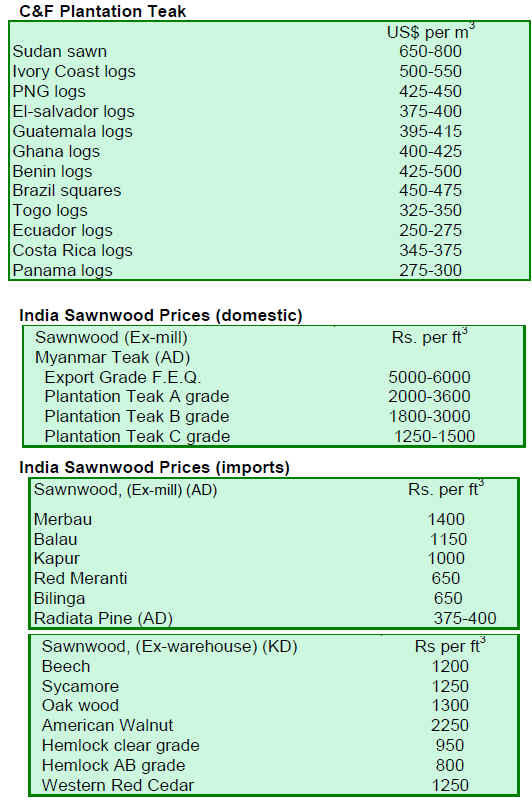
7. BRAZIL
¡®Ghost¡¯ timber companies in Par¨¢
The regional office of the Brazilian Institute of
Environment and Natural Resources (IBAMA) in Par¨¢ has
identified over 150 ¡®ghost¡¯ companies trading timber and
other forest products. This number is quoted in the interim
report of the so-called ¡°ghostbusters¡± operation, which
tracks the forest product flow in the state.
The ¡®ghost¡¯ companies identified by IBAMA are reported
to have provided false management plans and forest
control documents to support the purchase of and trade in
illegal timber. The receipts presented to inspectors were
from non-existent companies. In some cases, the plate
numbers of vehicles reportedly used for the transport of
forest products were those of regular passenger cars and
motorcycles, not timber trucks.
Through the ¡®ghost¡¯ companies, illegal timber could be
disguised as that coming from approved logging areas
with approved management plans. IBAMA is prosecuting
the offenders.
The Promadeira Fair
The seventh Promadeira Fair will take place in August this
year in Sinop, 500 km from Cuiaba. The region is
considered the largest timber manufacturing cluster in the
State.
This cluster of wood product industries apparently
provides some 40.000 direct and 120,000 indirect jobs.
The raw materials for the various industries come from
around 2.6 million hectares of sustainably managed forest.
There are plans to increase this to 6 million hectares.
In addition to the traditional international business
promotion activities of technical visits and product
exhibition, the up coming Fair will feature innovations
such as a display of a mini-forest with a demonstration of
sustainable forest management techniques.
Native tree seedlings will be distributed and there will be a
video presentation on "Standing Forest: the management is
possible," produced by the Timber Industry Association of
Northern Mato Grosso (Sindusmad) in partnership with
the Center for Wood Producers and Exporters of Mato
Grosso (CIPEM). This focuses on sustainable forest
management practices.
Falling exports from Northern Mato Grosso
Exports from the Alta Floresta tropical timber cluster fell
39% in January 2010 compared with the same period last
year according to the Ministry of Development, Industry
and Foreign Trade (MIDIC). Exports fell from US$
645,000 in January 2009 to US$595,700 in January this
year.
The major product traded was tropical timber
(US$568,400) but sales were down 38% compared to
January 2009.
The main importers were Spain, (accounting for US$
223,700, or 37.5% of the total export), followed by
Canada (US$155,100), the United States (US$ 142,200),
Belgium (US$ 47,300) and India which imported just
US$27,300 worth of wood products from the region.
Par¨¢¡¯s exports recover
The economy of Par¨¢ started to recover in January this
year after eleven months. Now the economy of Par¨¢ is
ranked second amongst the Brazilian States generating a
trade surplus of US$ 550 million.
Exports from Par¨¢¡¯s increased 13% in January 2010
compared to January 2009 from US$578 million to
US$657 million. In contrast to the situation in 2009 when
export declined sharply, there was a turnaround earlier this
year.
Wood product exports increased 19%, which analysts say
is significant given the deep recession in the sector last
year.
While wood product exports from Par¨¢ were just US$ 24
million in January 2009, in January this year they were
almost US$ 29 million.
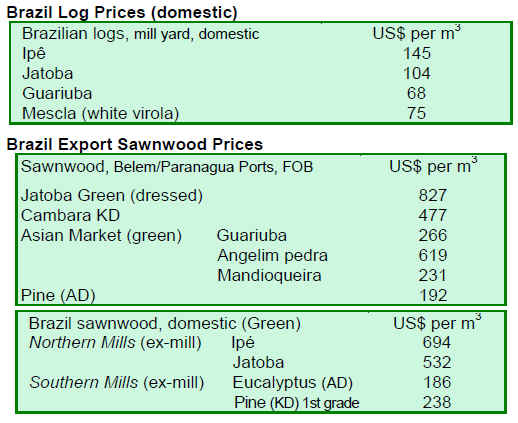
8.
PERU
FTA with EU
Peru¡¯s Minister of Foreign Trade and Tourism, Martin
Perez has reportedly said that while the Peru/EU FTA is
due to be signed in May this year, the agreement would
only become effective in two years time.
This is because there are 27 countries forming the
European Union and the trade agreement must be
approved by legislation in each of these countries.
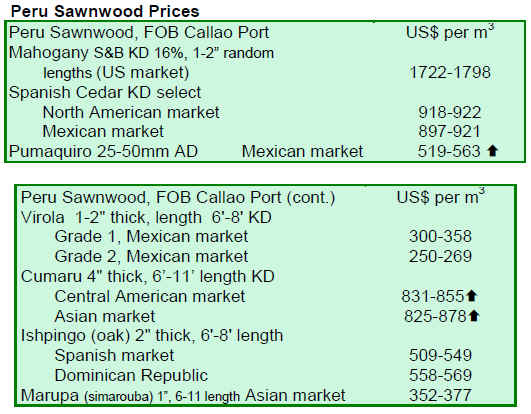
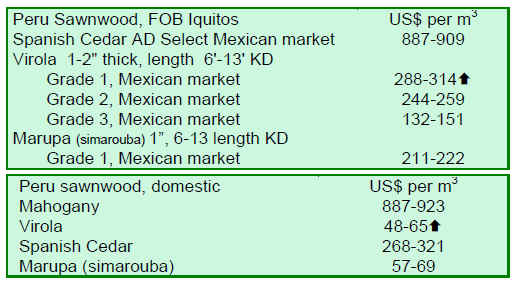
8.
Guyana
Log prices stable, sawnwood prices up
Over the period 16th ¨C 28th Feb, prices for logs were
relatively stable. However Greenheart standard sawmill
quality logs and Purpleheart fair sawmill quality logs
recorded price increases. There were also price
movements for Mora logs.
Sawnwood prices have risen sharply especially for rough
(Undressed) Greenheart select grade. The indications are
that prices have reached an average of US$1,510 per cubic
metre. Prices for rough sawn (Undressed) Mora have also
jumped to as much as US$1,341 per cubic metre, a record
high for the year thus far. Prices for other species such as
rough sawn Red Cedar and Wamara also experienced
favourable price trends over the period reported.
For dressed lumber, both Greenheart and Purpleheart
experienced a decrease in average prices for this fortnight
period.
On the other hand, Baromalli Plywood recorded an
increase in prices for both BB/CC and Utility categories.
The main market for plywood from Guyana is the
Caribbean countries and Suriname which at this point in
time are experiencing a housing boom.
Exports of value added products such as doors, mouldings
and non timber forest products all contributed to export
earnings. The Caribbean remains steadfast as the main
destination for these products from Guyana.
US Forest Service assistance
In January 2010, aid and technical assistance in the
forestry sector was discussed with a team of experts from
the United States Forest Service (USFS).
The USFS team met with representatives of the Guyana
Forestry Commission (GFC) and the Forest Products
Development and Marketing Council (FPDMC)
representatives.
The USFS/ USAID team reportedly proposed a series of
actions in key areas of forestry. In the interest of targeting
sustainable development objectives in the forestry sector,
the proposed actions were derived from broad areas in the
annual work plans of both the GFC and FPDMC.
The topics discussed included Fire Management;
Geographical Information System (GIS); Remote Sensing;
Reduced Emissions from Deforestation and Degradation
Plus (REDD+); and the National Forest Inventory.
Other areas examined for additional technical assistance
comprised testing of lesser used species, capacity building
in the areas of forest product development and marketing
and promotion.
The parties agreed that priority areas for capacity building
should be fire prevention and management, provision of
remote sensing and liaison with other organizations. The
testing of lesser used species for the purpose of making
indoor furniture as well as training in wood technology
and wood anatomy will also be addressed.

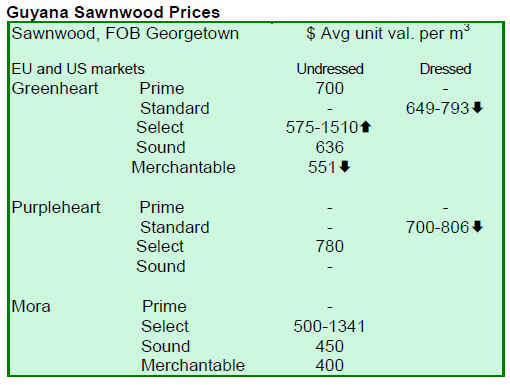
|